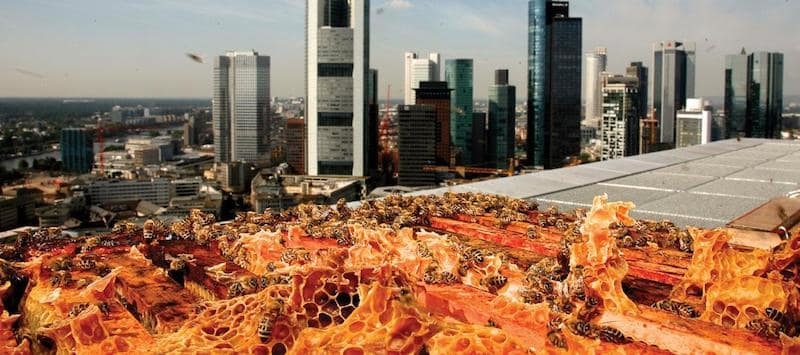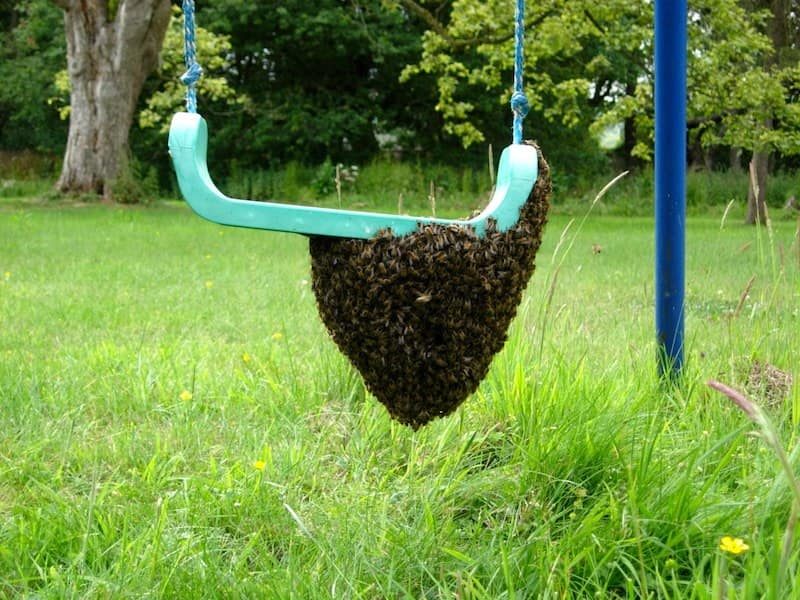Urbane bees
Urbane as in ‘of the city‘ as well as ‘polite and courteous‘.
Over 80% of the UK population live in towns. Although it’s unlikely that beekeepers are evenly distributed between urban and rural areas, it still means that most beekeepers (or wannabe beekeepers) probably live in towns. With the increase in the popularity of beekeeping over the last few years this inevitably means that more bees are being kept in towns than ever before.
Bees can do very well in towns
Cities have higher ambient temperatures {{1}} which effectively extends the season, starting earlier and finishing later in the year. These higher temperatures also provide more protection from extended cold periods during the winter.
Despite the depressingly obvious acres of grey concrete, cities can be remarkably ‘green’, with large parks and gardens in even some of the most densely populated areas. Satellite mapping analysis shows that cities like Liverpool, London and Edinburgh have 16 – 49% ‘green space’.
- Liverpool … 16% green space
- London … 23% green space
- Edinburgh … 49% green space
Many towns and cities have large numbers of well established trees, including lime and sycamore, both of which can give great honey. In addition, there are thousands of suburban gardens with a wide range of ornamental flowering plants.
As a consequence, city bees have access to a range of nectars throughout the season, helping create some strikingly good honey. There are entire businesses built around supplying honey from bees in the city – or cities – including the London Honey Company, Bermondsey Street Bees and the Sheffield Honey Company.
But it’s not all roses … or begonias or geraniums
However, a quick look at the honey sold by ‘city’ honey companies shows that only some of it originates from, er, cities. They also sell Suffolk coastal honey, heather honey, borage honey etc. Of course, this probably – and rightly – reflects demand. There’s a wonderful range of different honey produced in the UK, so why not sell it alongside honey from the city?
Except there isn’t any honey from the city available at the moment. All gone. Neither of the two London-based companies listed above have any London honey for sale {{2}}. Demand clearly outstrips supply.
And this is probably because supply is limited. Cities are surprisingly green, but many of the ornamental flowers favoured by gardeners are poor nectar producers and the trees are often planes, which produce no nectar for bees. With the increase in interest in beekeeping it’s been suggested that there are too many bees in cities {{3}}.
I don’t think the data to support this conclusion is good enough (yet). Hive numbers are certainly up significantly, but perhaps not as high as some think. Whether they’re at saturation level for the forage available will require analysis over several years, taking account of the actual honey yields, the weather and accurate information on colony density.
It’s interesting to note that Fera’s Beebase report the apiary density around my local apiary in rural Fife is 1/25th that of Central London (29 vs. 710 within a 10km radius). These figures aren’t reliable or even accurate … each apiary may have very different numbers of hives and significant numbers of beekeepers (perhaps as many as 50%) aren’t even registered on Beebase. Nevertheless, it probably gives a general indication of the relative density of hives.
Being neighbourly
There are more important issues than potentially poor honey yields with urban bees. Bees aren’t domesticated {{4}} and they can’t really be controlled. They forage where nectar and pollen is available, they drink water when they need it, they swarm when the colony is doing well and – there’s no real way to be delicate about this – they crap wherever they want. They can also get tetchy when forage becomes limiting, during stormy weather or when poorly handled.
All of which means that your bees might cause problems for your neighbours.

Poop target …
They’ll forage freely in their gardens, drink water from the bird bath or jacuzzi {{5}}, swarm en masse and hang pendulously from the climbing frame, and they’ll defecate repeatedly on the neighbours recently waxed and polished BMW.
These are not insignificant issues and they shouldn’t be ignored.
If you’ve got bees, whatever the evidence (or lack of it), it will be your bees that sting your neighbours grandchild, poop on their Beemer and swarm onto the garden swing.
Guilty until proven innocent.
Good urban beekeeping practice
I’ve kept bees in an urban garden and, while I can’t really advise on how you establish and maintain good relations with your neighbours {{6}}, I can provide some beekeeping hints to make their life – and yours – a bit easier.
These are more or less in order of importance …
- Make sure you have access to an out apiary over three miles away. Perhaps the training apiary for your association, or a friend with a large rural garden. Arrange this in advance, not when an angry neighbour is remonstrating with you about his toddler and anaphylaxis. Seriously. Some problems are only solved by moving bees away and you might need to do this in a hurry.
- Put out a bait hive at the beginning of the season. You might stop a swarm from your own bees disappearing over the fence (but see 3). More importantly, another swarm from the neighbourhood might neatly hive themselves rather than ending up in the neighbours garden. Brownie points {{7}} for you and no blame can be attached! I’ve never failed to catch swarms with bait hives in urban or semi-urban gardens … and they weren’t mine because I always clip my queens. Which brings me to …
- Always clip your queens. Although clipping the wing of a queen does not stop swarming, it does stop the swarm flying off. They’ll usually end up on the hive stand or underneath the floor.
- Learn, and get good at, swarm prevention and control. Provide space for the colony before it’s needed, replace queens regularly, control colony expansion by taking off a nuc, conduct timely splits to control swarming and reunite to requeen. If you don’t yet know what these things are then there’s quite a bit to learn. Are you ready to keep bees in your town garden?
- Keep well-tempered bees and keep them well-tempered (see 8). Aggressive bees are unpleasant at the best of times. They make beekeeping a chore if you’re in the corner of a remote field. In town they’re an abomination. Requeen or move them immediately with any repeated tendency to show signs of bad behaviour.
- Engineer the flight lines to force bees up and away. If you situate the hive(s) in a corner facing into a fence or wall the foragers will be forced to fly up and over the obstacle, ideally well over head height. I’ve seen this done very successfully using an open-topped netting cage. My bee shed is surrounded by security fencing with 2″x6″ mesh … >95% of the foragers choose to fly over this rather than through the mesh {{8}}.
- Be sensible about when you conduct your weekly inspections. Not when there’s a children’s party next door, not on the first warm, sunny day for a fortnight (when everyone is outside) and not when there’s a thunderstorm predicted and the bees are already agitated. You’ll find this is surprisingly restrictive. You’ll want to inspect your colony on the same day everyone else is enjoying the good weather. I used to keep my bees about six feet from where my neighbour parked their car to unload the shopping … I lost count of the number of times I had to abandon an inspection as they returned from Sainsburys. And they seemed to do a lot of shopping 🙁
- Learn to inspect your colonies well. This is perhaps the most difficult thing to achieve for a beginner. The idea is that you conduct a thorough inspection while causing the minimum disruption to the colony. ‘Thorough‘ so you’re confident about what’s happening in the colony (and so don’t need to do it too frequently). The ‘minimum disruption‘ is important so you don’t leave agitated bees flying around for ages afterwards. This is a skill and is generally only learned with lots of experience – minimal smoke, gentle handling of the frames, proper examination of each frame, no crushed bees (so no alarm pheromone) … with all this being achieved quickly.
- Good Varroa management. Controlling Varroa means your colonies are likely to stay strong, so they are less likely to be robbed out by the dozens of other colonies in the area. This is both responsible beekeeping and stops the sort of frenzied mobbing of bees around the hive that are likely to really worry the neighbours.
Forewarned is forearmed
As I’ve said before, the principles of beekeeping are really rather simple. It’s practice – lots of it – that is needed to acquire the necessary skills to keep bees well. I’d argue that good beekeeping is particularly important in towns because your mistakes, or the intransigence of the bees, don’t just cause you a problem. They potentially cause problems – or at least concerns – for your neighbours.
That’s neither fair or responsible.
Some of the best beekeepers I know keep quite large numbers of colonies in surprisingly small suburban gardens. Do not underestimate the skill needed to achieve this. All of them have somehow arrived at a method of beekeeping that addresses all of the points above.
But I’ve also been asked to urgently requeen double brood colonies in tiny town gardens that were so aggressive they needed a double beesuit over a fleece for protection, where the garden was off-limits and where inspections had been completely abandoned.
I hate to think of the problems this caused their neighbours … or the additional bad publicity for beekeeping in general.
Colophon
Urbane means (of a person, especially a man) courteous and refined in manner. It’s derived from Middle French urbain which meant both polite, courteous, elegant and belonging to a city. This in turn is derived from Classical Latin urbanus meaning much the same. For an article about bees in towns the word seemed remarkably appropriate, referencing both cities and the need for courteous and refined behaviour.
Of the bees … and the beekeeper 😉
About the only thing wrong with the current use of the word is that it is usually applied to males.
🙄
{{1}}: This is due to the Urban Heat Island which is nicely described in a brief article by Gerald Mills in The Conversation
{{2}}: At the time of writing … mid-January 2018.
{{3}}: Which means London as that’s where the data largely comes from … though some dispute the data.
{{4}}: Actually, this is perhaps debatable if you’re interested in semantics … but I’ll save that for another post.
{{5}}: I don’t know what your neighbourhood is like … I could have expanded the list to include abandoned car tyres, swimming pools or Capability Brown-designed ornamental lakes.
{{6}}: Hint … a few jars of honey at Christmas is always a winner.
{{7}}: A hypothetical social currency for doing a good deed. Although widely regarded as originating from the ‘points’ Brownies (junior Girl Guides) needed for badges, there are equally compelling alternative etymological explanations.
{{8}}: You can stand a metre of so away from, and in line with, the entrances to half a dozen colonies with hundreds of foragers a minute flying over your head, whilst remaining completely untroubled by them.





Join the discussion ...